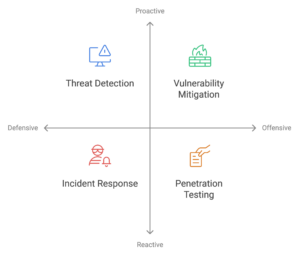CISOs are more important now than ever before
AI is moving fast—faster than most people realize—and is creating entirely new vectors for cybersecurity risks. Every AI algorithm, every IoT device, every byte of data carries potential vulnerabilities. Companies must treat cybersecurity as their first line of defense in this brave new world, and a sharp Chief Information Security Officer (CISO) is the one steering that ship.
The demand for this unique mix of technical mastery, strategic vision, and leadership is skyrocketing, but the supply is limited. Great CISOs are rare. They must manage boardrooms with as much confidence as they oversee technical teams. They need to speak the language of CEOs and CTOs while also decoding complex risks into actionable strategies.
Great CISOs are people who can translate the abstract—AI risks, ransomware vulnerabilities—into business decisions that protect data, revenue, and reputation.
Without a strong CISO, companies are playing with fire. Cyber adversaries evolve daily, and new risks emerge with every AI investment or connected device. Organizations need a leader who thinks five moves ahead, and treats cybersecurity as a dynamic, competitive advantage.
Structure the CISO role to attract top talent
If you want the best, you have to offer a position that reflects its importance. You can’t bury the CISO role in a tangle of IT operations or treat it as a side gig for someone else. Top-tier CISOs expect clarity. They need to know what they’re walking into, how much influence they’ll wield, and where they’ll sit in the hierarchy.
Ideally, a CISO should report directly to the CIO—or even sit as their peer, depending on how high the stakes are for your organization. If your data is mission-critical, or a security breach could sink the business, give the CISO enough authority to act decisively. Are they protecting enterprise security, product security, or both? Will they have a dedicated team, or are they expected to manage security in a matrixed organization? These questions need answers before you start recruiting.
Here’s the thing though: talented CISOs are looking for signs that your organization takes security seriously. If the position feels like an afterthought, you’re not going to land the best. But, when you structure the role with foresight—giving it teeth and visibility—you’re more likely to attract someone who’s ready to deliver game-changing results.
Educate the board on cyber governance
Boards aren’t always up to speed on cybersecurity. They often think it’s about buying the right tools and hoping for the best. Real security, however, is about understanding human behavior, anticipating mistakes, and building resilience. A strong board doesn’t need to know every technical detail, but they do need a clear grasp of what’s at stake and how cyber risks intersect with business strategy.
When your board shows it gets this—when they understand the nuances of cyber governance—it sends a clear message to potential CISOs. It says, “We’re not here to micromanage; we’re here to empower.”
A board that’s already familiar with cyber risk is a better partner for the CISO and a magnet for top talent. Why? Because no high-performing leader wants to spend their time explaining the basics. They want a board that’s ready to roll up its sleeves and back strategic decisions with confidence.
Organizations should prime their boards to view cybersecurity as more than a technical hurdle. Cyber risks are a business problem, and governance should reflect that. A well-educated board signals that your company doesn’t see cybersecurity as a value driver. And that’s a winning message for attracting elite CISOs.
Balance defensive and offensive cybersecurity approaches
The best CISOs don’t exclusively play defense. Sure, they manage risk and protect assets, but they also think offensively—leveraging technology to drive growth. Cybersecurity, when done right, helps companies innovate without fear, to expand into new markets with confidence.

Balance defensive and offensive cybersecurity approaches
Here’s what great CISOs look for: Are IT investments aligned with business goals? Is technology treated as a growth engine, or is it seen as a necessary expense? If all the talk around IT revolves around cutting costs, don’t expect top-tier candidates to stick around. They’re drawn to organizations that view technology as a strategic advantage.
Companies must show they value innovation. CEOs should be talking openly about how technology fuels the business. Boards should understand how secure systems unlock opportunities. When CISOs see that the leadership team is committed to a forward-thinking, tech-savvy strategy, they know they’re walking into an environment where their work will be valued. That’s the kind of mindset that attracts high-performing leaders.
Showcase strong change management
Most people don’t like change. It’s hard, messy, and uncomfortable. When it comes to cybersecurity though, getting people to adopt new behaviors is half the battle. The best CISOs know this. They are “change architects” as well as technologists.
Organizations that excel in change management stand out to top talent. A strong change management team makes it clear that security is about people. Employees need to understand the value of protocols and see how their actions fit into the bigger picture.
This isn’t something you can fake during an interview. If you’ve invested in supporting a culture of education and behavior change, showcase it. Highlight how your leadership team supports security initiatives and how the company drives adoption. Change management is quickly becoming a must-have skill for CISOs. It’s not enough to have the technical know-how, they also need to inspire action across the organization.
Involve the board in the interview process
Actions always speak louder than words. When a CISO candidate sees board members actively participating in their interview, it’s a clear signal that cybersecurity is taken seriously. It’s one thing to say that security is a priority—it’s another to show it.
Board involvement also benefits both sides. For the candidate, it’s an opportunity to gauge how the board thinks about security. Are they engaged? Do they understand the challenges? For the board, it’s a chance to assess whether the candidate can communicate effectively at their level. This early interaction sets the tone for what will be one of the most important relationships in the company.
Final thoughts
Here’s the question every CEO should ask themselves: Is your business treating cybersecurity as a cost to manage or as a competitive advantage to leverage? The threats aren’t slowing down, and neither are the opportunities for innovation. Are you ready to make that kind of hire, someone who can turn security into strategy and risk into resilience?




